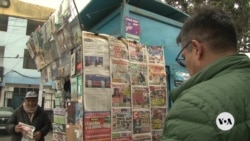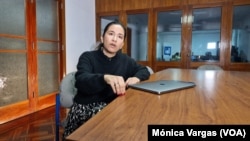When journalists at IDL-Reporteros published a story exposing corruption at the highest levels in Peru, they expected the story to make a splash.
What they didn’t expect was more than a year of attacks, threats, a newsroom raid, smear campaigns, and legal action over their coverage.
In May last year, shortly after IDL-Reporteros published a series of stories, a crowd gathered outside the media outlet’s office. The journalists filmed as garbage, flares, and excrement were thrown toward them.
And this March, a criminal investigation opened into IDL-Reporteros' founder Gustavo Gorriti, accusing him of bribery. The investigation seeks the identity of his team’s sources.
Gorriti and the media outlet’s team deny the accusations.
“These attacks, the level of violence, the aggressiveness of the attacks and the judicial cases are a consequence of having investigated the people with power and having revealed cases of public interest that are relevant to our society,” said Managing Editor Romina Mella.
The purpose of such assaults, Mella added, is “to be able to frighten journalists.”
Since Gorriti founded the site in 2009, IDL-Reporteros has made a name for itself investigating public interest stories. Among them, the so-called Lava Jato, or Car Wash, case.
The investigation into two decades of irregular payments from Brazilian company Odebrecht found evidence appearing to link some of Peru’s former presidents to the case, along with political and business leaders.
Public officials and four former presidents came under investigation or are being prosecuted.
For Gorriti, the reporting showcases public watchdog media at its best.
“When investigative journalism does it[s] job well, when it gets to the bottom of things and it gets the truth of the facts that matter, that is when it counts.”
The Lava Jato case “has been the largest investigation into massive corruption at the intersection of the public and the private sectors that has been carried out in this century in Peru,” Gorriti told VOA.
But it has brought consequences.
Mella said IDL-Reporteros took the lead in reporting on the case, working with other newsrooms on the story.
Because of that, she said, “A series of disinformation campaigns began to intensify and occur, which have developed in parallel with threats, attacks on social media and also threats and raids on the editorial office.”
The media outlet’s investigations into those assaults suggest links to politicians they reported on. And, said Mella, other media outlets have spread misinformation, including about Gorriti.
A spokesperson for Peru’s prosecutor's office did not respond to VOA’s request for comment.
‘Serious risk’
Gorriti is a leader in Peruvian investigative journalism. A position that has brought a series of threats and attacks during his career.
But he very nearly chose a different career path — at one point even dabbling in farming — before making the move to media when he was 30.
His first job at a magazine involved reporting on the conflict in Peru in the 1980s. His experiences at that time are documented in his book, “Sendero,” about the Shining Path guerrilla war movement.
In the ’90s he published reports on Vladimiro Montesinos, the then powerful intelligence adviser of President Alberto Fujimori who was imprisoned for crimes against humanity, corruption and arms and drug trafficking.
During that time, Gorriti was kidnapped “with the intention of being disappeared,” he says. International pressure on his case led to his release.
Now 76 and in recovery for cancer treatments, Gorriti again is weathering threats.
As well as the legal risk to Gorriti, lawyers say the case has wider press freedom implications, because prosecutors are requesting access to confidential sources.
If granted, said lawyer Carlos Rivera, “That would not only mean violating the guarantee of freedom of expression, such as the confidentiality of sources of information, but also the possibility of getting illicit access to all of the journalists’ sources of information.”
The investigation, said Rivera, “is placing journalists at a very serious risk.”
For Gorriti, such challenges come with the job.
“I am at an age at which many people have already retired,” he said. “But I am working more than I did when I was 20 years old.”
He noted that from the start of his media career, he knew there would be challenges, telling VOA, “I understood that this was like crossing a river, and from that moment, there was no turning back.”
His case reflects wider issues affecting media in Peru with media watchdogs and international bodies, including the Inter-American Commission on Human Rights, noting a rise in attacks alongside cases of judicial harassment.
Peru’s National Association of Journalists has stated that physical and verbal aggression is resulting in a record number of attacks against journalists, who also endure threats and harassment, obstacles to access to information and judicial intimidation.
The country also dropped 48 places in the past two years on the World Press Freedom Index. Compiled by Reporters Without Borders, the index notes that conditions for media in Peru “are deteriorating as the political system becomes increasingly opaque.”
Peru also fell three points in Transparency International’s Corruption Perceptions Index.
Against that backdrop, the work of investigative journalists like those at IDL-Reporteros remains tough. But Gorriti said they will not be deterred.
“Never allow fear to be your editor, never allow it,” he told VOA.








